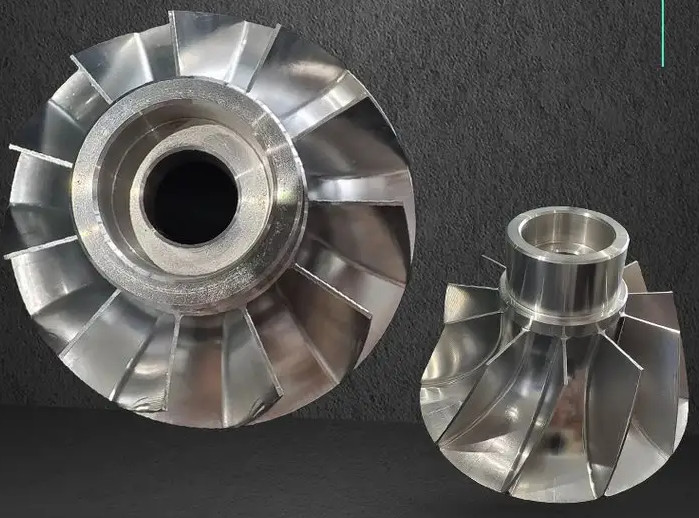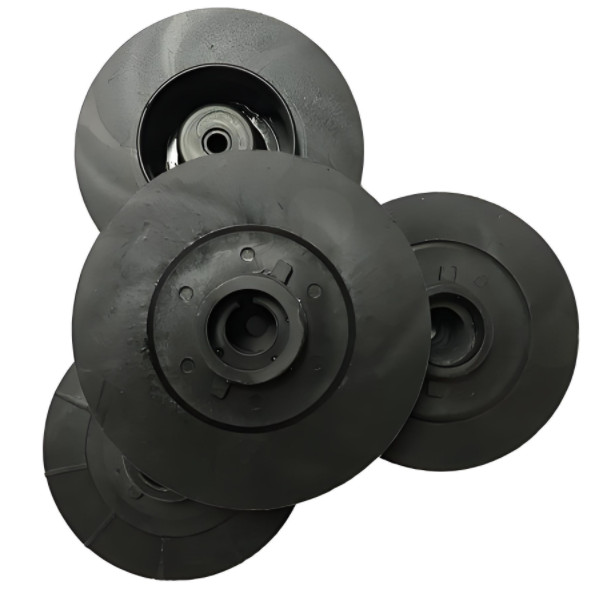Titanium alloy impellers are critical components in industries such as aerospace, marine, and chemical processing due to their high strength-to-weight ratio, excellent corrosion resistance, and biocompatibility. However, their performance in harsh environments, such as those involving corrosive media or high mechanical stress, can be limited by surface wear and corrosion susceptibility. Electroplating, as a surface treatment method, offers a viable solution to enhance the corrosion resistance and durability of titanium alloy impellers. This article provides a detailed examination of electroplating processes tailored for titanium alloys, their impact on corrosion resistance, and the optimization strategies to achieve superior impeller performance.
Properties of Titanium Alloy Impellers
Titanium alloys, such as Ti-6Al-4V (Grade 5), are widely used for impellers due to their unique properties. These alloys exhibit a high specific strength (approximately 1000 MPa yield strength at a density of 4.43 g/cm³), excellent fatigue resistance, and inherent corrosion resistance due to the formation of a stable titanium dioxide (TiO₂) passive film upon exposure to oxygen. This oxide layer, typically 5–6 nm thick, provides protection against many corrosive environments, including seawater and acidic solutions. However, under conditions such as high temperatures (>80°C), low oxygen content (<1 ppm), or abrasive contact, the passive film can degrade, leading to localized corrosion, such as pitting or crevice corrosion.
Impellers operate in dynamic environments where they are subjected to mechanical stress, fluid erosion, and chemical attack. For example, in marine applications, impellers face chloride-rich seawater, which can initiate pitting corrosion if the TiO₂ film is compromised. In chemical processing, acidic media (e.g., hydrochloric acid) can accelerate corrosion. Therefore, surface treatments like electroplating are employed to reinforce the surface properties of titanium alloy impellers, enhancing their longevity and reliability.

Electroplating Process for Titanium Alloys
Electroplating involves depositing a metallic coating onto a substrate through an electrochemical process, improving surface properties such as corrosion resistance, hardness, and wear resistance. However, titanium’s high chemical reactivity and the presence of its passive oxide layer pose challenges to achieving strong coating adhesion. The electroplating process for titanium alloys requires meticulous surface preparation and precise control of plating parameters.
Surface Preparation
Effective surface preparation is critical to ensure coating adhesion. The natural TiO₂ film on titanium alloys inhibits direct metal deposition, necessitating its removal or modification. Common preparation steps include:
- Mechanical Cleaning: Abrasive blasting with silica or alumina particles (grain size 50–100 µm) to remove surface contaminants and increase surface roughness (Ra ≈ 0.5–1.0 µm).
- Chemical Etching: Immersion in an acidic solution, such as 10% HF + 30% HNO₃ at 25°C for 1–2 minutes, to dissolve the oxide layer and activate the surface.
- Electrochemical Activation: Anodic etching in a 5% H₂SO₄ solution at a current density of 0.5–1.0 A/dm² for 30 seconds to further clean and activate the surface.
- Strike Plating: Application of a thin intermediate layer, typically nickel (1–2 µm thick), using a low-current-density (0.2–0.5 A/dm²) nickel strike bath (e.g., 240 g/L NiSO₄, 45 g/L NiCl₂, 30 g/L H₃BO₃, pH 4.0) to enhance adhesion of subsequent coatings.
These steps ensure a clean, activated surface with improved wettability, enabling uniform coating deposition.
Electroplating Techniques
Several electroplating techniques are suitable for titanium alloys, each offering distinct advantages in terms of coating properties. The choice of technique depends on the desired coating material and application requirements. Common methods include:
- Conventional Electroplating: Uses a direct current (DC) to deposit metals like nickel, chromium, or platinum. For example, nickel plating is performed in a Watts bath (300 g/L NiSO₄, 60 g/L NiCl₂, 40 g/L H₃BO₃, pH 3.5–4.5) at 50°C with a current density of 2–5 A/dm², yielding a coating thickness of 10–50 µm.
- Electroless Plating: An autocatalytic process that deposits a nickel-phosphorus (Ni-P) alloy without an external current. A typical bath contains 25 g/L NiSO₄, 30 g/L NaH₂PO₂, and stabilizers like sodium citrate, operating at 85°C and pH 4.8–5.2. Coating thickness ranges from 5–20 µm with a phosphorus content of 7–10 wt%.
- Pulse Plating: Employs pulsed current to improve coating uniformity and reduce internal stresses. For chromium plating, a pulse frequency of 100 Hz and a duty cycle of 50% at 3 A/dm² can produce a dense, crack-free coating (20–30 µm thick).
Nickel and chromium are commonly used as base or intermediate layers, while noble metals like platinum or palladium may be applied for enhanced corrosion resistance in extreme environments.
Post-Plating Treatment
Post-plating treatments improve coating performance and durability. Heat treatment at 200–400°C for 1–2 hours in a vacuum or inert atmosphere (e.g., argon) enhances coating adhesion and relieves residual stresses. Additionally, sealing with organic coatings or passivation in a 5% HNO₃ solution at 25°C for 30 minutes can further improve corrosion resistance by closing micro-pores in the coating.

Enhancing Corrosion Resistance through Electroplating
Electroplating significantly enhances the corrosion resistance of titanium alloy impellers by providing a protective barrier against corrosive media and reinforcing the passive oxide layer. The effectiveness of electroplated coatings depends on their composition, thickness, and microstructure.
Coating Materials and Their Corrosion Performance
Different coating materials offer varying levels of corrosion protection. The following table summarizes common electroplated coatings for titanium alloys and their performance in corrosive environments:
| Coating Material | Composition | Thickness (µm) | Corrosion Resistance | Typical Applications |
|---|---|---|---|---|
| Nickel | Ni (99.9% purity) | 10–50 | Good in neutral and mildly acidic environments; susceptible to pitting in chloride-rich media | Intermediate layer, chemical processing |
| Nickel-Phosphorus | Ni (90–93%), P (7–10%) | 5–20 | Excellent in acidic and alkaline solutions; uniform coating | Marine, oil and gas |
| Chromium | Cr (99.8% purity) | 20–50 | Superior in oxidizing acids and high-temperature environments | Aerospace, high-wear applications |
| Platinum | Pt (99.95% purity) | 1–5 | Outstanding in aggressive media (e.g., HCl, chlorine gas) | Chemical processing, high-value components |
Nickel-phosphorus coatings are particularly effective due to their amorphous structure, which minimizes grain boundaries and reduces corrosion pathways. Platinum coatings, while costly, provide near-inert protection in extreme conditions, such as those involving hydrochloric acid or chlorine gas.
Electrochemical Performance
Corrosion resistance is evaluated through electrochemical tests, such as potentiodynamic polarization and electrochemical impedance spectroscopy (EIS). For example, a Ni-P coated Ti-6Al-4V impeller tested in 3.5% NaCl solution at 37°C exhibits a corrosion potential (E_corr) of approximately -0.25 V (vs. Ag/AgCl) and a corrosion current density (i_corr) of 0.1 µA/cm², compared to -0.35 V and 0.5 µA/cm² for uncoated Ti-6Al-4V. The higher E_corr and lower i_corr indicate improved corrosion resistance. EIS measurements reveal a higher charge transfer resistance (R_ct) for coated samples (e.g., 10⁵ Ω·cm² vs. 10⁴ Ω·cm² for uncoated), confirming the protective nature of the coating.
Environmental Factors
The performance of electroplated coatings varies with environmental conditions. In chloride-rich environments (e.g., seawater), coatings must resist pitting corrosion. Nickel-phosphorus coatings with 7–10% phosphorus content are effective due to their dense, non-porous structure. In acidic environments (pH < 3), platinum or chromium coatings are preferred due to their chemical inertness. High temperatures (>120°C) can degrade nickel coatings, necessitating the use of chromium or composite coatings (e.g., Ni-P-TiC) with enhanced thermal stability.
Optimization Strategies for Electroplating
Optimizing the electroplating process for titanium alloy impellers involves balancing coating properties, process efficiency, and cost. Key strategies include:
Process Parameter Control
Precise control of plating parameters ensures consistent coating quality. Critical parameters include:
- Current Density: 2–5 A/dm² for nickel plating; lower densities (0.5–1 A/dm²) for strike plating to avoid hydrogen embrittlement.
- Bath Composition: Stable electrolyte formulations (e.g., 240–300 g/L NiSO₄ for nickel plating) to maintain coating uniformity.
- Temperature: 50–60°C for nickel plating; 80–90°C for electroless Ni-P to optimize deposition rate and coating density.
- pH: 3.5–5.0 for most nickel-based baths to prevent precipitation and ensure coating adhesion.
Automated plating systems with real-time monitoring of these parameters enhance process reliability.
Composite Coatings
Incorporating particles like TiC, SiC, or graphene into nickel or nickel-phosphorus matrices improves coating hardness and corrosion resistance. For example, a Ni-P-TiC coating with 1.5 g/L TiC particles in the bath achieves a Vickers hardness of 593 HV and a corrosion current density of 0.08 µA/cm² in 3.5% NaCl solution. The particles act as physical barriers, reducing corrosion ion penetration.
Multilayer Coatings
Multilayer coatings, such as Ni/Cr or Ni-P/Pt, combine the benefits of different materials. A typical structure involves a 10 µm nickel base layer for adhesion, followed by a 20 µm chromium layer for corrosion and wear resistance. These coatings exhibit a synergistic effect, with improved durability in complex environments like high-speed, chloride-rich fluids.
Practical Considerations
While electroplating enhances impeller performance, practical considerations include:
- Cost: Noble metal coatings (e.g., platinum) are expensive, limiting their use to high-value applications. Nickel-based coatings offer a cost-effective alternative.
- Coating Thickness: Thicker coatings (e.g., 50 µm) provide better protection but increase processing time and material costs. Optimal thickness (10–20 µm) balances performance and economy.
- Environmental Impact: Electroplating baths containing heavy metals require proper waste management to comply with environmental regulations.
- Substrate Integrity: Excessive chemical etching or high current densities can introduce hydrogen embrittlement, reducing the mechanical properties of the titanium alloy.
Addressing these considerations ensures the practical viability of electroplating for industrial applications.

Conclusion
Electroplating is a robust method for optimizing the surface treatment of titanium alloy impellers, significantly enhancing their corrosion resistance and durability. Through meticulous surface preparation, controlled plating processes, and strategic coating selection, electroplated titanium impellers can withstand harsh environments, such as chloride-rich seawater or acidic chemical media. Nickel-phosphorus and chromium coatings offer cost-effective solutions, while noble metals like platinum provide superior protection for critical applications. By implementing precise process control, composite coatings, and multilayer structures, manufacturers can achieve reliable, high-performance impellers tailored to specific operational demands. This systematic approach ensures that titanium alloy impellers meet the stringent requirements of aerospace, marine, and chemical processing industries.
